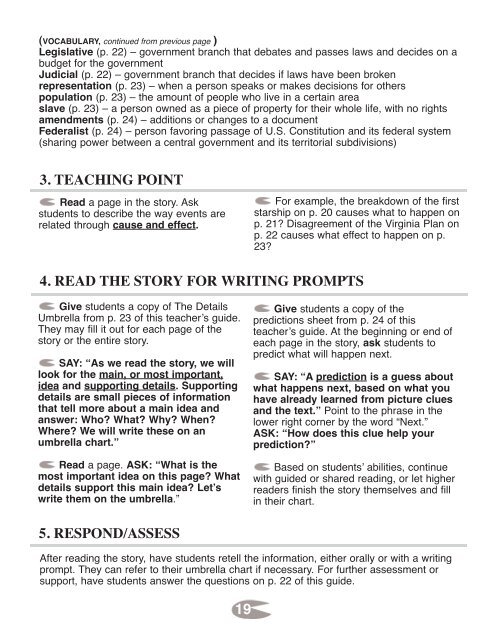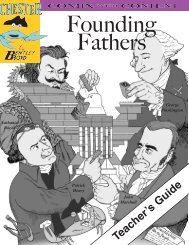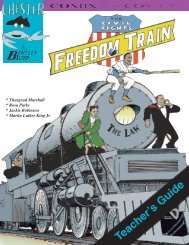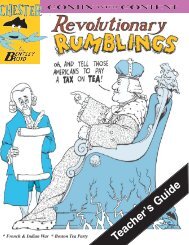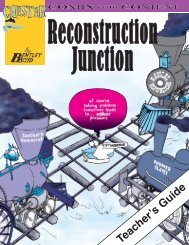Constitution Construction - Chester Comix
Constitution Construction - Chester Comix
Constitution Construction - Chester Comix
Create successful ePaper yourself
Turn your PDF publications into a flip-book with our unique Google optimized e-Paper software.
(VOCABULARY, continued from previous page )<br />
Legislative (p. 22) – government branch that debates and passes laws and decides on a<br />
budget for the government<br />
Judicial (p. 22) – government branch that decides if laws have been broken<br />
representation (p. 23) – when a person speaks or makes decisions for others<br />
population (p. 23) – the amount of people who live in a certain area<br />
slave (p. 23) – a person owned as a piece of property for their whole life, with no rights<br />
amendments (p. 24) – additions or changes to a document<br />
Federalist (p. 24) – person favoring passage of U.S. <strong>Constitution</strong> and its federal system<br />
(sharing power between a central government and its territorial subdivisions)<br />
3. TEACHING POINT<br />
Read a page in the story. Ask<br />
students to describe the way events are<br />
related through cause and effect.<br />
For example, the breakdown of the first<br />
starship on p. 20 causes what to happen on<br />
p. 21? Disagreement of the Virginia Plan on<br />
p. 22 causes what effect to happen on p.<br />
23?<br />
4. READ THE STORY FOR WRITING PROMPTS<br />
Give students a copy of The Details<br />
Umbrella from p. 23 of this teacherʼs guide.<br />
They may fill it out for each page of the<br />
story or the entire story.<br />
SAY: “As we read the story, we will<br />
look for the main, or most important,<br />
idea and supporting details. Supporting<br />
details are small pieces of information<br />
that tell more about a main idea and<br />
answer: Who? What? Why? When?<br />
Where? We will write these on an<br />
umbrella chart.”<br />
Read a page. ASK: “What is the<br />
most important idea on this page? What<br />
details support this main idea? Letʼs<br />
write them on the umbrella.”<br />
Give students a copy of the<br />
predictions sheet from p. 24 of this<br />
teacherʼs guide. At the beginning or end of<br />
each page in the story, ask students to<br />
predict what will happen next.<br />
SAY: “A prediction is a guess about<br />
what happens next, based on what you<br />
have already learned from picture clues<br />
and the text.” Point to the phrase in the<br />
lower right corner by the word “Next.”<br />
ASK: “How does this clue help your<br />
prediction?”<br />
Based on studentsʼ abilities, continue<br />
with guided or shared reading, or let higher<br />
readers finish the story themselves and fill<br />
in their chart.<br />
5. RESPOND/ASSESS<br />
After reading the story, have students retell the information, either orally or with a writing<br />
prompt. They can refer to their umbrella chart if necessary. For further assessment or<br />
support, have students answer the questions on p. 22 of this guide.<br />
19


